1a. Gymnopus - collybioid
(caps can be >2.5 cm across), odorless, not turning
green in KOH (easily confused with section 3 - collybioid Collybiopsis)
Gymnopus
dryophilus EU - has a somewhat hygrophanous warm orange-brown cap and stem,
and a bald stem. It was
named after oak but found ubiquitously throughout any forest. No bulb and
white rhizomorphs.
Gymnopus 'dryophilus
PNW09' - Some local sequences match very well to the type
sequence, but most of them differ by 7 bp or so in ITS2, although they are still
almost an exact match (only 1 bp different) in ITS1. It's a little unusual to find such asymmetry
in areas that supposedly randomly mutate. A 2013 Antonin paper could find no morphological or ecological
differences between them, and for now it is all considered one species, only
distinguishable by ITS2, but I am noticing that these "alternate clade"
collections often have yellow or orange-brown (the cap colour) on the stems,
whereas the collections that better match the type sequence have white or
orange-brown on the stems, without yellow. That usually makes the caps of
PNW09 darker than the stem. Perhaps we could call it Gymnopus
dryophilus var. flavipes.
Gymnopus aquosus EU
- a spring lookalike we never noticed was here (we undoubtedly thought they were G.
dryophilus) until DNA showed us it was. It supposedly has a stem bulb
and pink rhizomorphs.
It seems to have slightly paler colours when fresh than G. dryophilus,
but G. dryophilus quickly fades to resemble G. aquosus. ITS DNA of G. aquosus
varies a bit more than the usual 0.5% around the world, but it's all considered
one species.
Gymnopus 'aquosus
PNW04' (alpinus
EU/junquilleus NC/subsulphureus KS complex) - some sequences of spring
collections of G.
aquosus are about 1% different, practically
exactly the same as the ITS DNA of a few sister species that all share the same
ITS DNA. Those species have a very dark red-brown cap (G. alpinus) or are
entirely bright yellow (G. junquilleus and G. subsulphureus). At
least two of them have been shown to interbreed, so perhaps our local
collections with this sequence do not represent a separate species but represent
G. aquosus of the first group with "pure" ITS DNA hybridizing with one of
the different looking species but still retaining its own character. This is an
interesting puzzle.

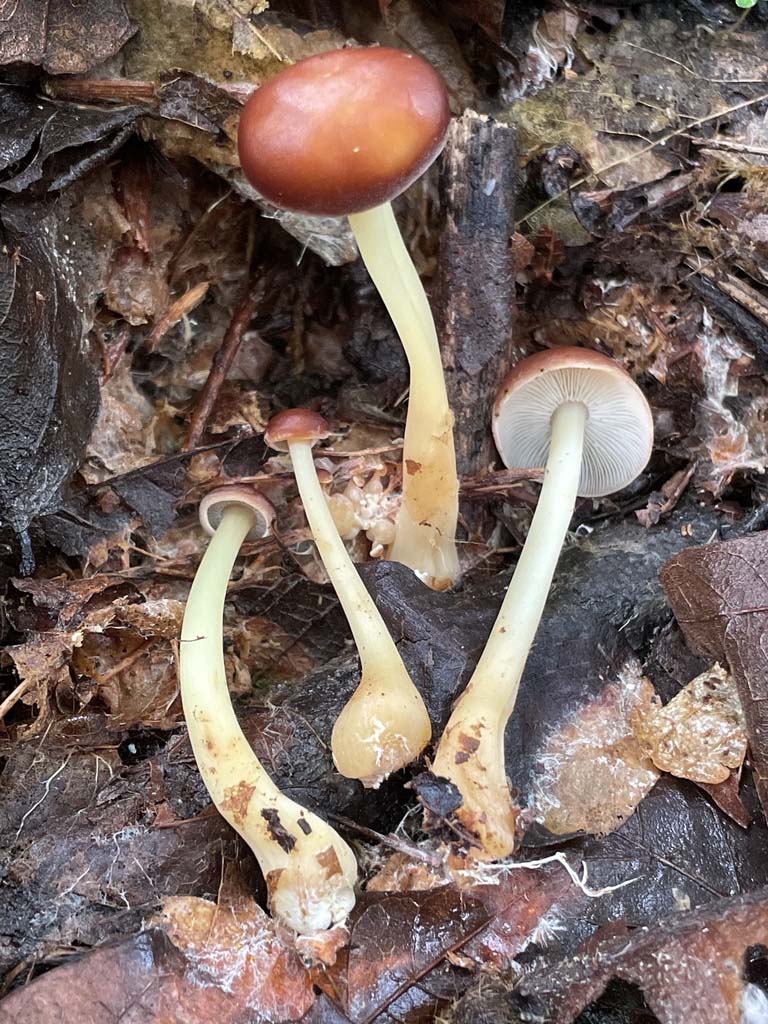
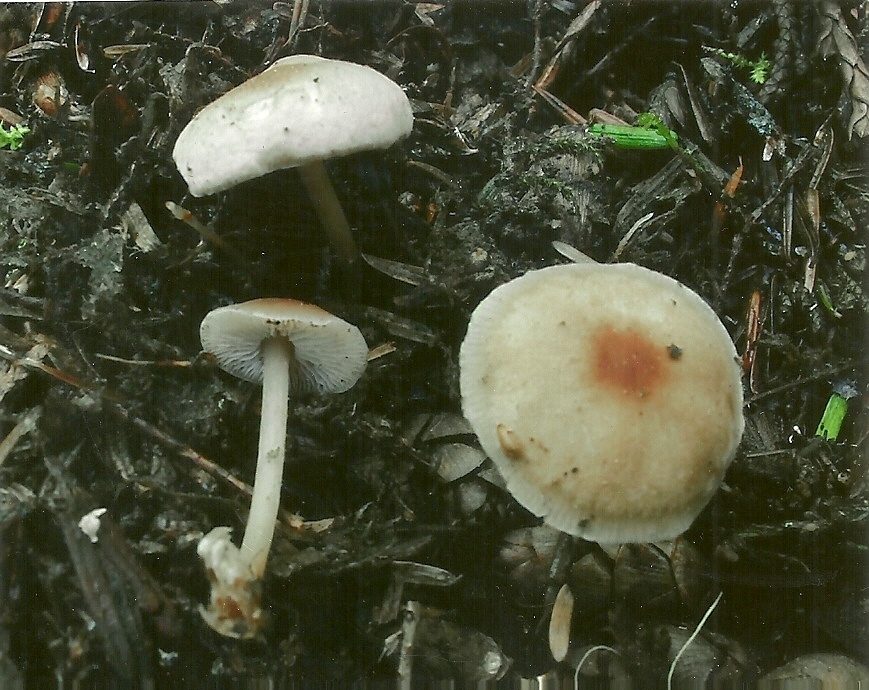
.jpg)
Gymnopus dryophilus and 'dryophilus PNW09' (yellow stem) © Bruce Newhouse and
Yi-Min Wang, G. aquosus ©
Buck McAdoo, G. 'aquosus PNW04' © Buck McAdoo
Gymnopus ocior EU - a
darker, colder wine-coloured cap, possibly with yellowish gills,
growing in disturbed urban places like wood mulch. This species has
serrated gill edges like Rhodocollybia, in fact it is believed that
Rhodocollybia extuberans is a synonym of this species, but see below
under Rhodocollybia for a discussion on that name. This was also not known from the PNW
until we sequenced collections that were either mistaken for G. dryophilus
or that were not recognized. Two WA sequences match EU sequences quite well.
Collybia luteifolia EU is thought to be a synonym of G. ocior, and
indeed an old herbarium collection (UBC F31726) turned out to be G. ocior.
'Gymnopus' striatipes NY -
not a Gymnopus, but in Rhodocollybia described below.
Gymnopus
CA01 - dark chestnut brown cap
that is
strongly striate once the cap is expanded. The stem may be hairy near the
bottom. G. 'earleae PNW05' is usually less striate. Collybiopsis villosipes has a completely hairy stem.
Gymnopus CA02 turns green in KOH, like I thought this species would,
since it is closely related, but so far both collections where that has been
tested have not.
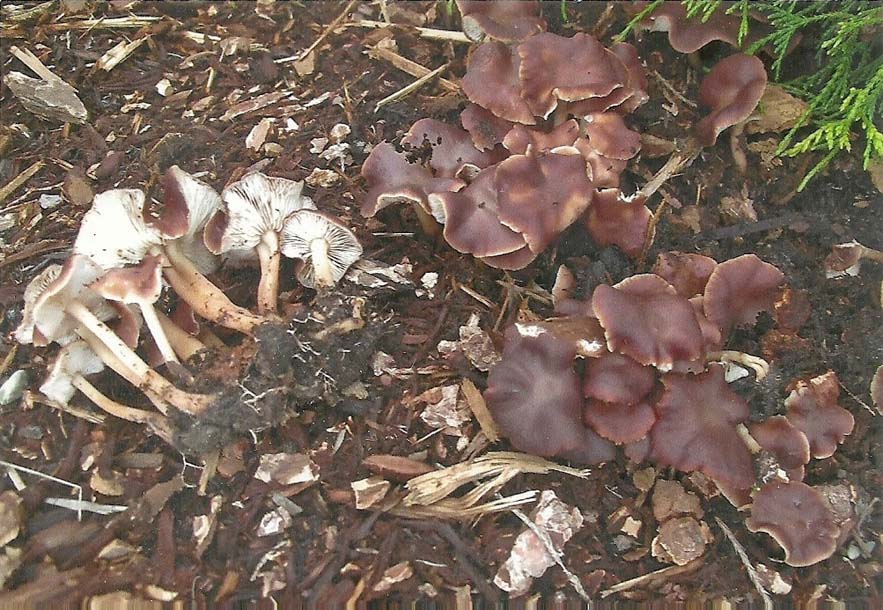
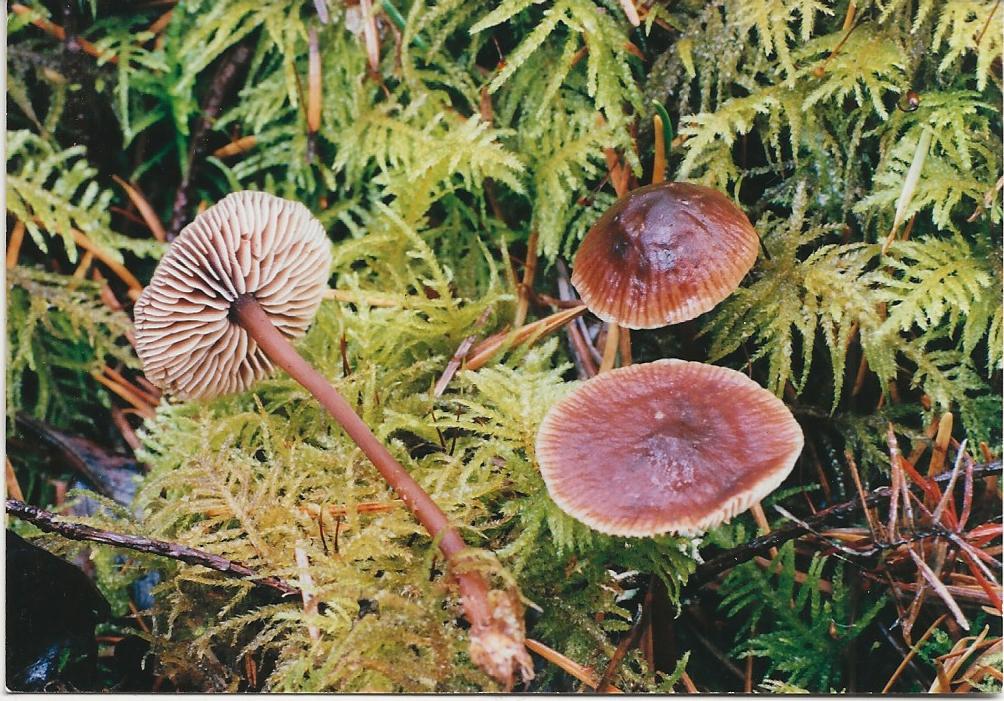
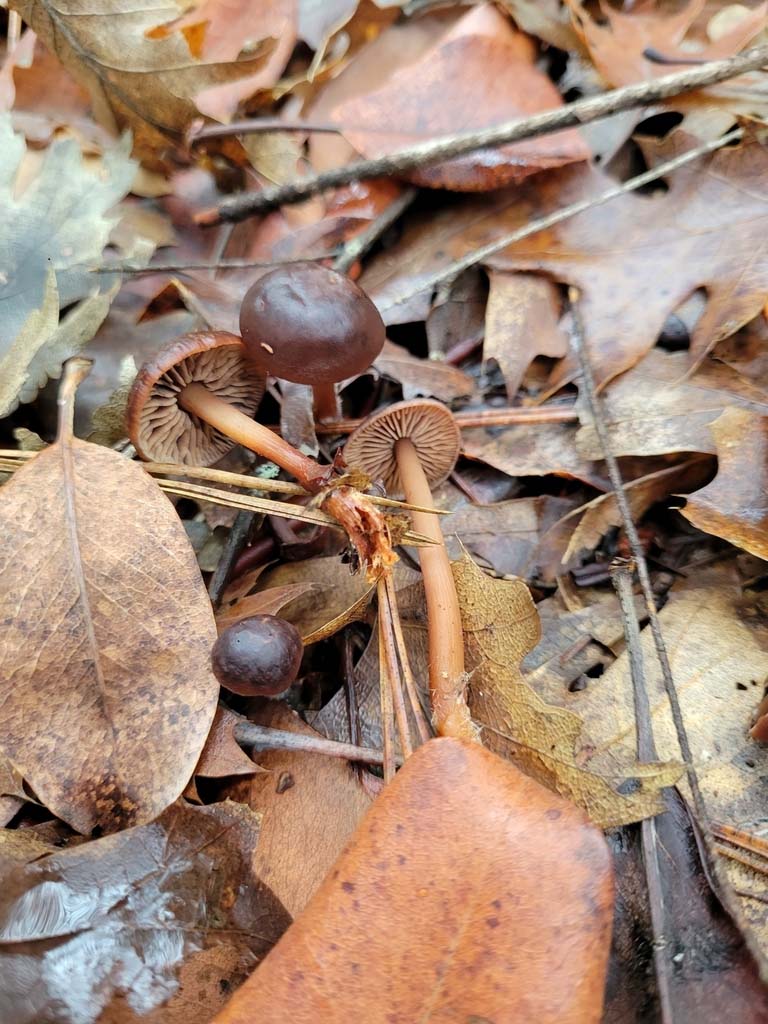
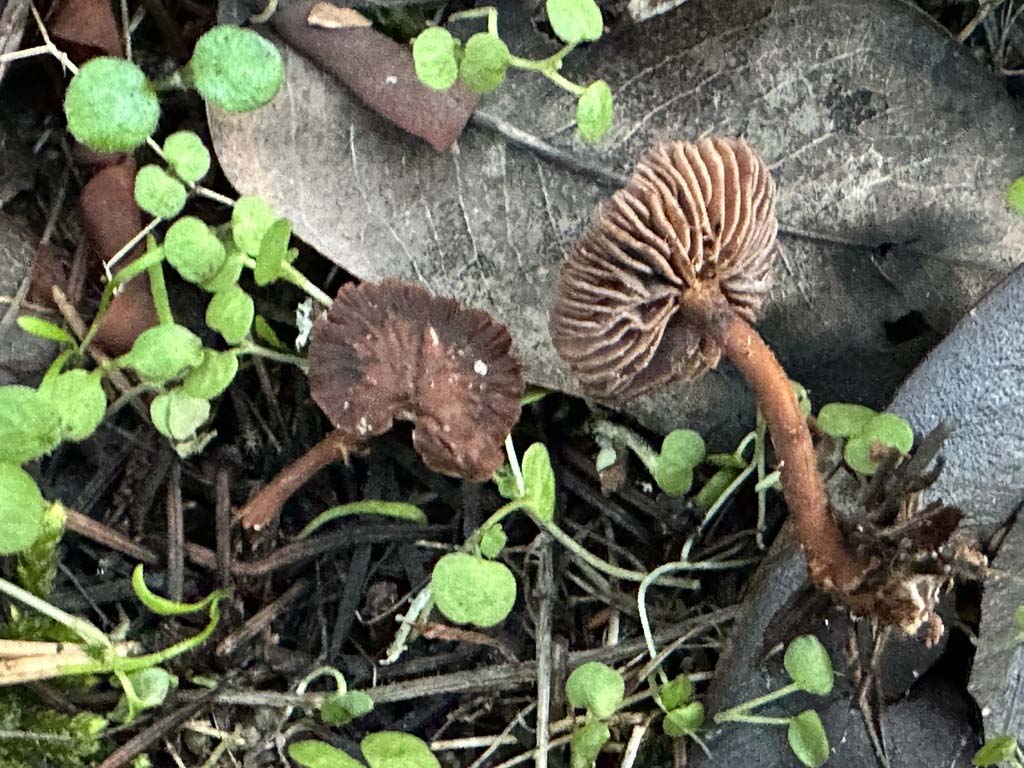
Gymnopus ocior © Buck McAdoo, G. CA01 © Buck
McAdoo, Harte Singer, and Jonathan Frank
1b.
Gymnopus - collybioid, odorless, turning green in KOH
Gymnopus erythropus EU -
notable for its strongly two-toned stem grading from dark reddish brown
below to paler orange above, but some collections don't have much of a pale
upper stem and are difficult to identify. The cap fades from darker brown to
lighter brown. Many local sequences match many EU sequences. Occasionally
collections smell like rotting cabbage, even though this species is not in
the garlic clade covered next. Those collections have identical sequences to the
ones that don't have an odor.
Gymnopus CA02 ('fuscopurpureus'
misapplied?) - this lookalike, also closely related to Gymnopus
spongiosus SC, may have an entirely pubescent stem and did turn green in KOH.
Gymnopus fuscopurpureus
EU and Gymnopus alkalivirens VA
have been reported from the PNW but we don't have reliable sequences of either
of those, although it starting to seem unlikely that either species is found in
the PNW. The sequences of this species vary by up to 3 bp and also in a couple
ambiguous locations. It has been found in BC, WA, and CA.
An old herbarium collection (UBC F33880) labeled G. spongiosus turned out
to be Gymnopus 'dryophilus PNW09' so that doesn't help.
Gymnopus 'fuscopurpureus
PNW08' -
dark greyish brown everywhere. Perhaps the lower stem is pubescent. KOH
bright green on the cap. There are many competing concepts for what a
sequence of the EU species G. fuscopurpureus really is, but our species
seems unlikely to be it.
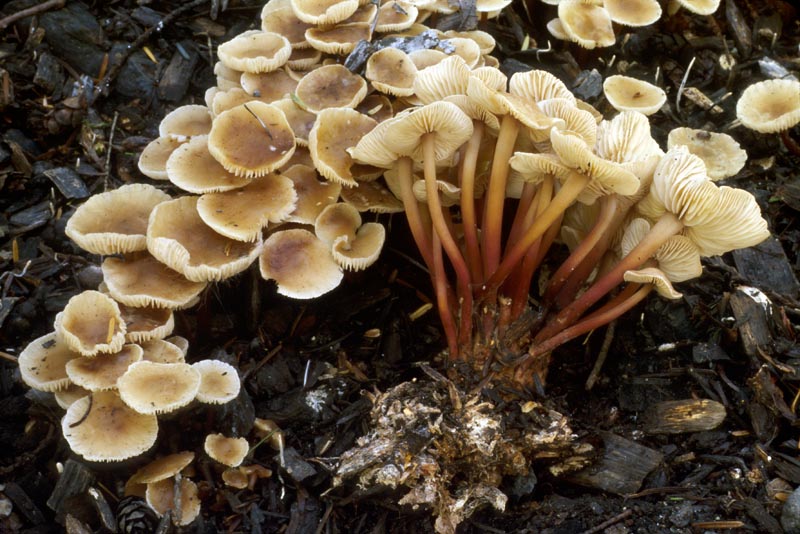
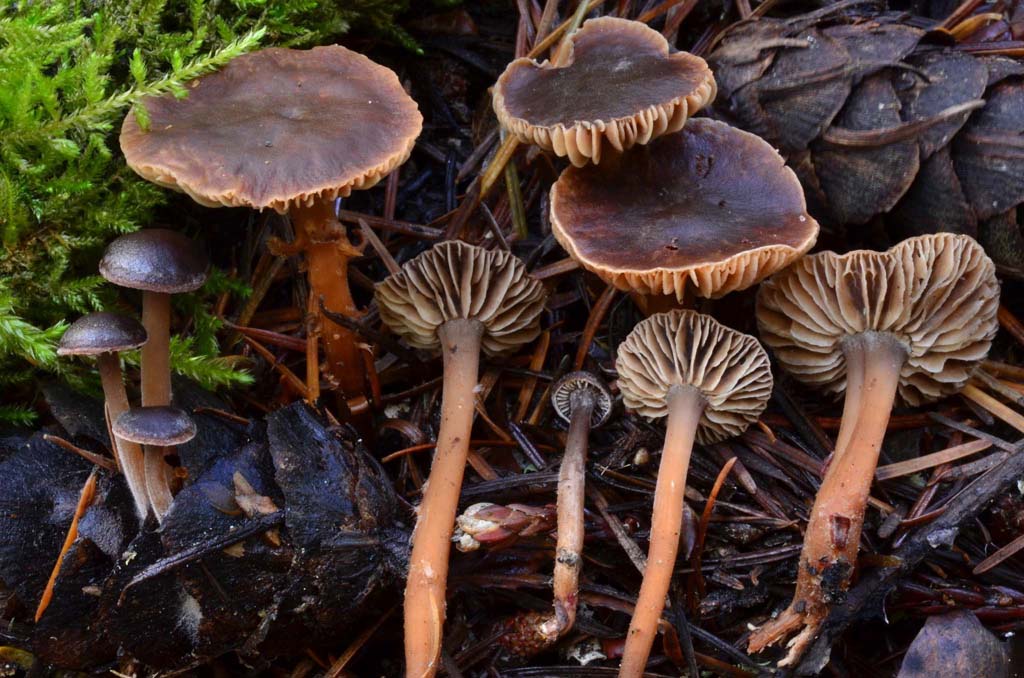

Gymnopus erythropus
© Steve Trudell, Gymnopus CA02 (from CA) © Christian Schwarz, G. 'fuscopurpureus PNW08' ©
Andrew Parker
Gymnopus PNW01 - Distant ochre gills,
orange brown cap, two toned stem that is orange brown on the bottom
half, possible fuzzy stem, turns green in KOH. Spores
(5.5-6.8) x (3.6-3.7)u.
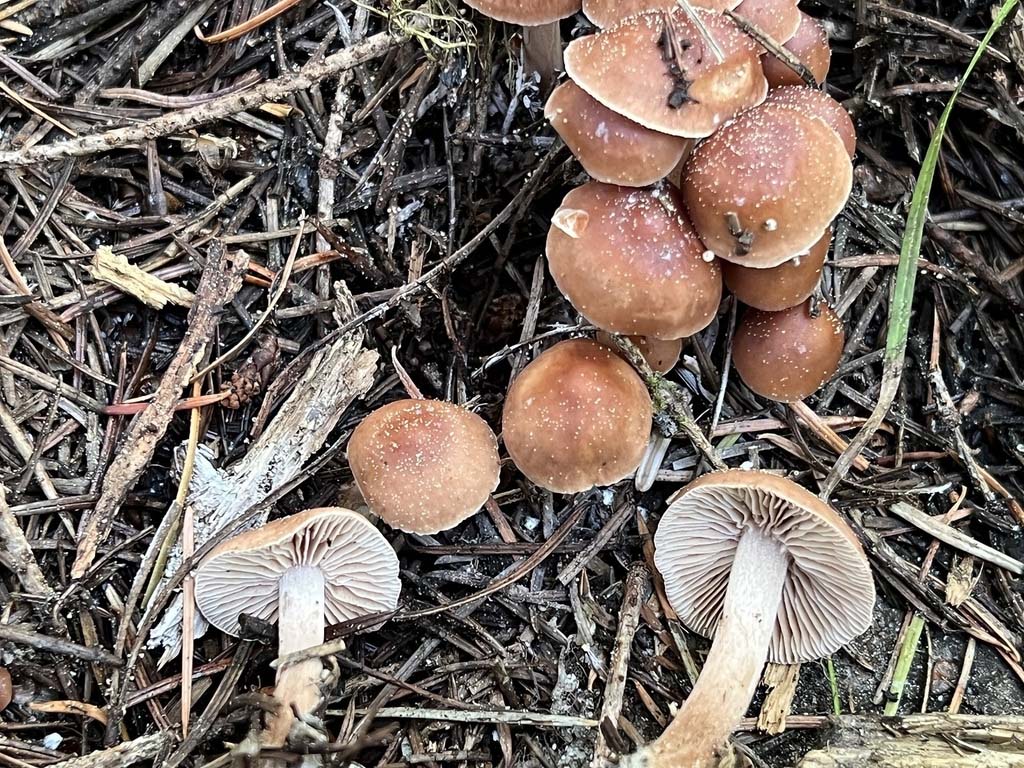
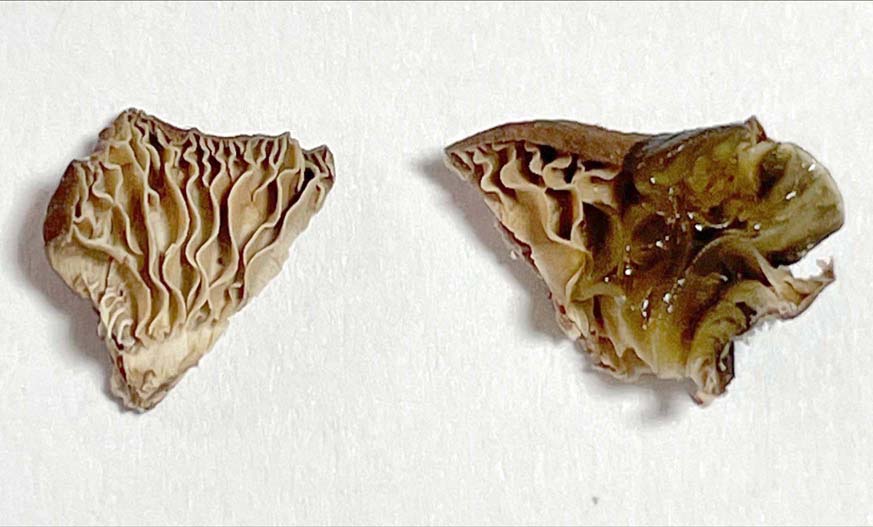
Gymnopus PNW01 © iNaturalist user joemat, green KOH
reaction © Yi-Min Wang
Gymnopus 'earleae PNW05' AL (Gymnopus vernus EU
misapplied?) - usually has a darker
chestnut brown colour than G. dryophilus, but may also be orange like
the latter, found in spring as well
as fall. A dried specimen has has been noted to turn dark brown in KOH,
and has been mistaken for species that turn green in KOH on several occasions,
so it might turn green in KOH when fresh. It is similar to the green KOH species Gymnopus
CA02 above, but usually less striate. It is
also similar to but less striate than Collybiopsis villosipes, further
below, but that species has a hairy stem. This species was also not previously known
from the PNW, having also been mistaken for G. dryophilus or just not
recognized. There are 2 competing concepts from eastern North America about what
G. earleae is. Out west we find one of them, but I can't say for sure if
it's the real one or the unnamed lookalike. We need more AL sequences, if not
the type to find out. It's possible that reports of the similar G. vernus EU
represent this (it's a very similar spring mushroom) but I don't know, so if you think you find the real G. vernus
here, save it.
Gymnopus PNW10 - a sister
species to PNW05 (5% different in ITS). The two times it was collected in BC, it was mistaken for
Gymnopus putillus EU, mentioned below. It was photographed from 2
collections in CA. It turns dark brown to possibly green in KOH. However,
another theory is that Gymnopus putillus may be a Rhodocollybia.
Gymnopus PNW11 - we have
one OR collection and a number from CA. It needs to be tested for turning green
in KOH.
Gymnopus PNW12 - known
from WA and OR. One dried collection didn't appear to turn green in KOH, but
another one did. Its proximity in the tree to PNW01 implies it should.


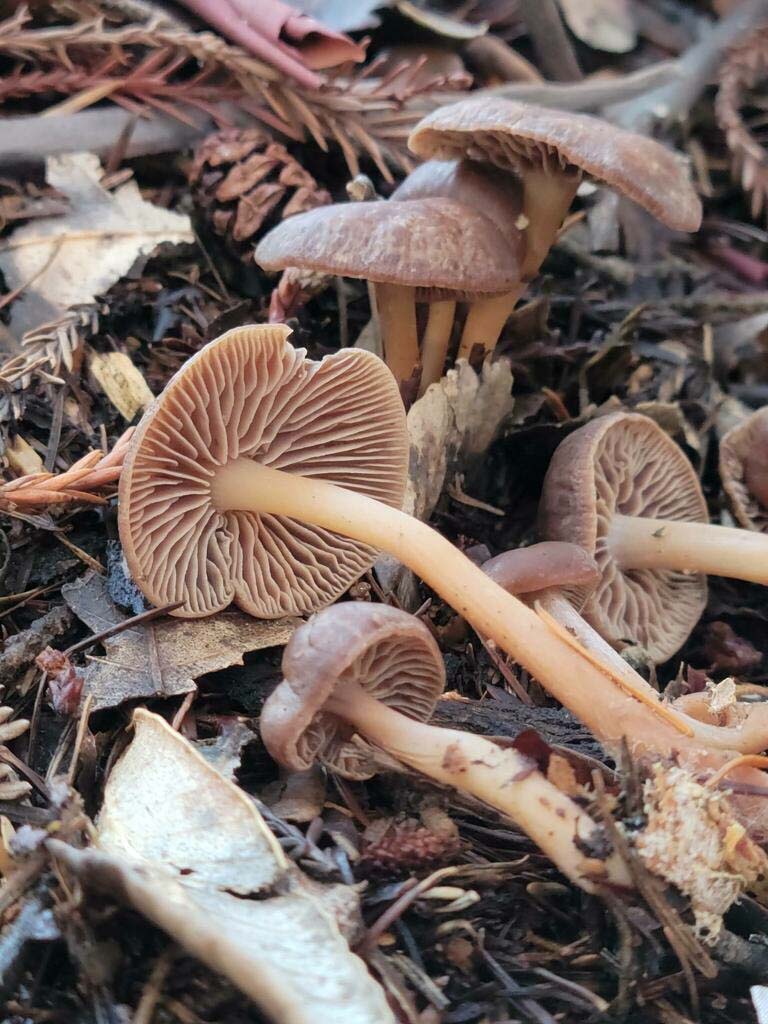
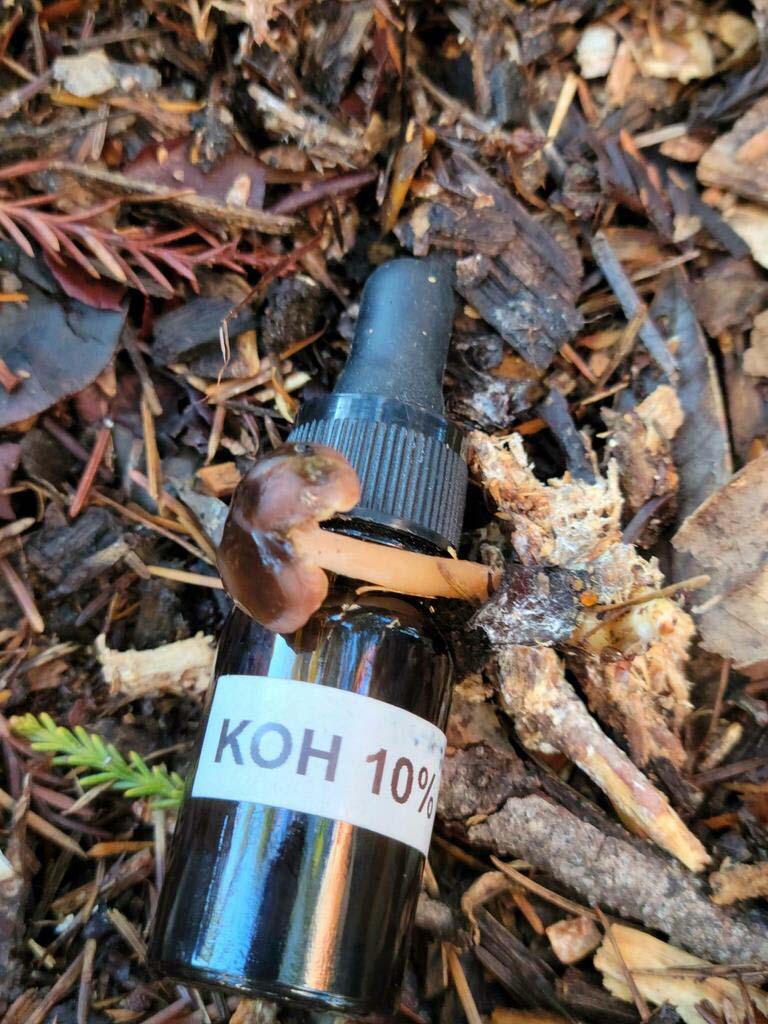
Gymnopus 'earleae PNW05' © Buck McAdoo,
Gymnopus PNW10 © Harte Singer (3 images)
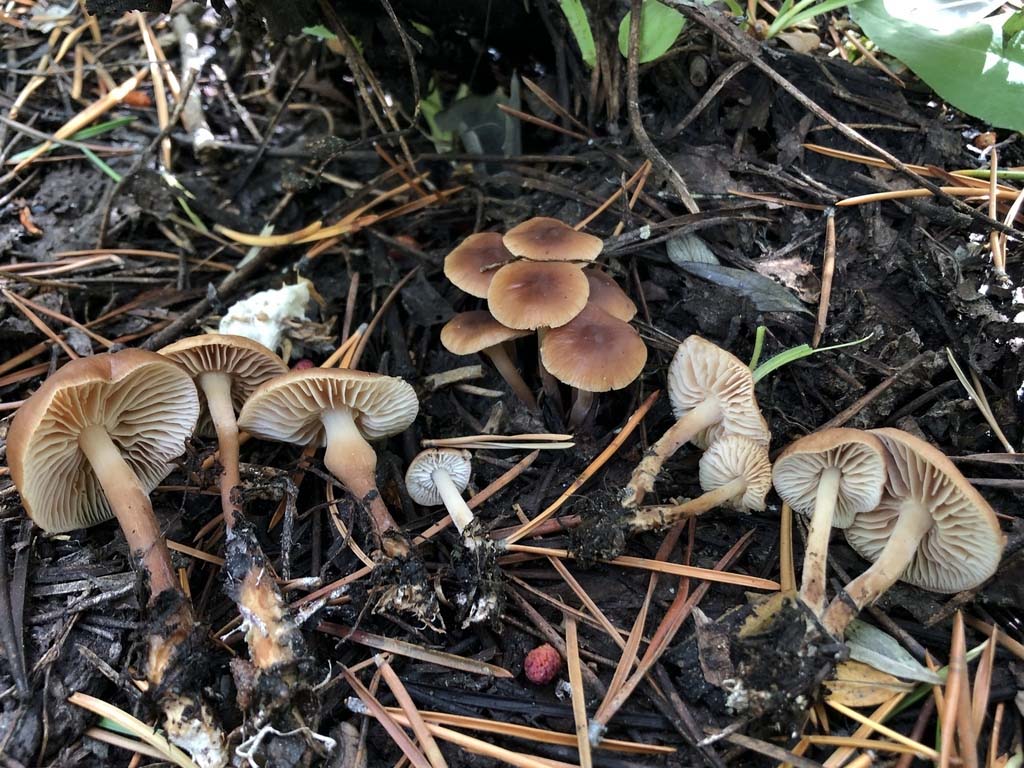
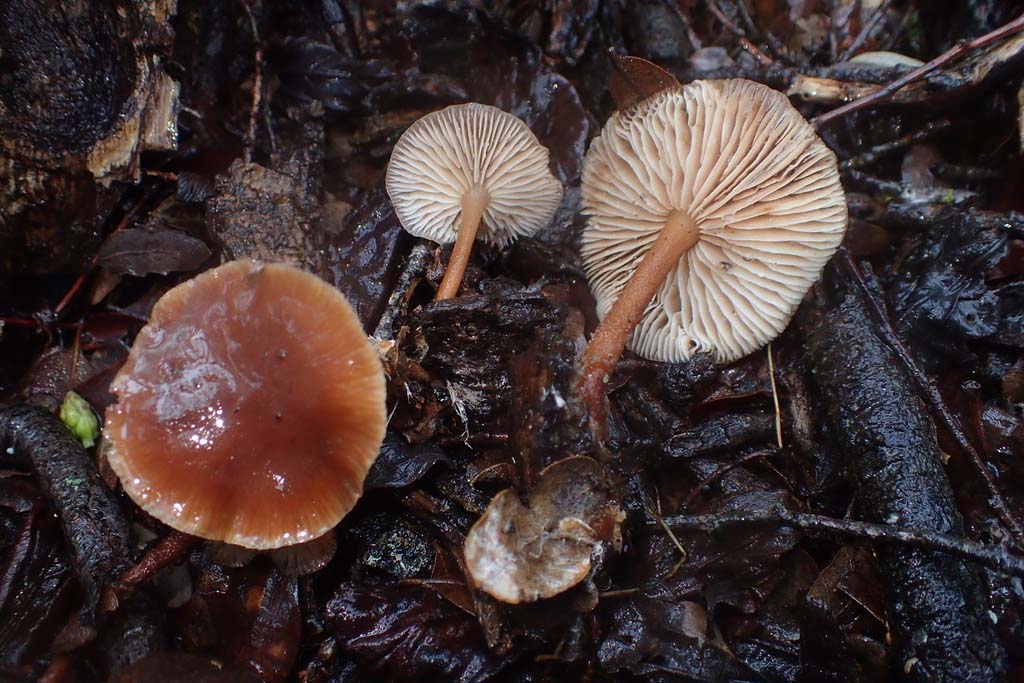

Gymnopus PNW11 © Dean Lyons (from CA) and Damon Tighe (from CA),
G. PNW12 © Ed Barge
1c. Gymnopus - collybioid, garlic/cabbage odor (but note that G. erythropus
above may smell of rotten cabbage and 'Micromphale' arbuticola is a small
marasmioid)
Gymnopus
impudicus EU (Gymnopus dysodes misapplied?) - this is our species
with a dark red brown cap (when fresh) and distant gills. Also,
the
stem is white or coloured like the cap and all colours fade in age. There
is a strong
garlic/onion odor. It was thought that Gymnopus impudicus EU was found in the wild
and the similar Gymnopus dysodes MA was found in wood chips (but with a very
striate cap, larger spores, and cheilocystidia). So far, we have sequenced collections from both
the wild and woodchips that are not prominently striate, and they have all
matched EU type area sequences of G. impudicus. We need collections with
a strongly striate cap, large spores, and cheilocystidia to see what they are. One other thing to
check when figuring out which (or both) species are here is whether or not KOH turns green with either species, as it is
supposed to at least with G. dysodes, even though it doesn't clade with
other KOH positive species. Another thing to note is that Gymnopus hariolorum
EU was reported once from Idaho. Around the world, this species seems to be
easily confused with G. impudicus but has paler, closer gills. This
should also be looked out for.
One old herbarium collection that was labeled as G. dysodes (UBC
F34950) turned out to be Collybiopsis villosipes.
Gymnopus barbipes TN - one BC
collection is very close to the type sequence. This species is described as
having an indistinct odor and taste, even though it is just a few bp away
from G. impudicus. Unfortunately the odor and taste of the BC collection
were not noted. We have to look for it again.
Gymnopus 'polyphyllus PNW03' -
a pale yellow-tan cap with very crowded gills and a strong
garlic odor. There was one vague 30 year old report of it in the PNW, and we
finally found something that looks like it, but it is an unnamed relative and
not the real thing described from NY. We should keep collecting it to see if the
real thing is also here. Our local collection smelled more like rotting
cabbage than garlic.
Gymnopus cf.
brassicolens EU - much like G. erythropus but always smells like rotting
cabbage/garlic. Its two toned stem is almost blackish purple on the
bottom. It is reported from CA and to be looked for in Oregon, but it is
possible that cabbage smelling collections of G. erythropus were found
and mistaken for this. We need collections of this.
'Micromophale'
arbuticola CA - a much smaller marasmioid garlic mushroom growing
on
the bark of madrone. It has yet to be moved to Gymnopus but should,
in fact it is in the same clade with all these others, probably closest to
Gymnopus foetidus, it just unfortunately evolved to be smaller than the
others. We need ITS sequences of it; we don't have any yet. Our common 'Micromphale' perforans was moved to Paragymnopus when Micromphale was split
between the two genera.
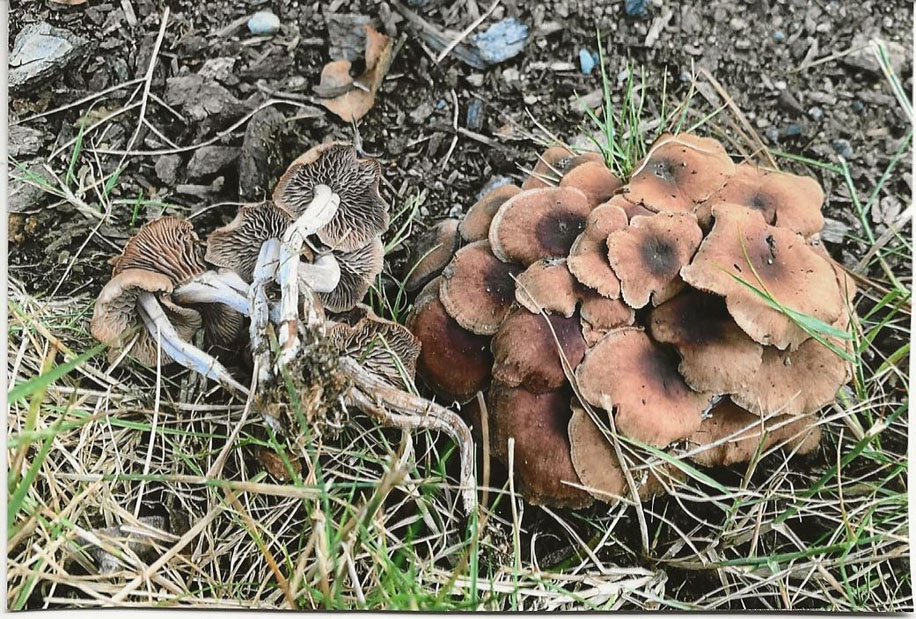
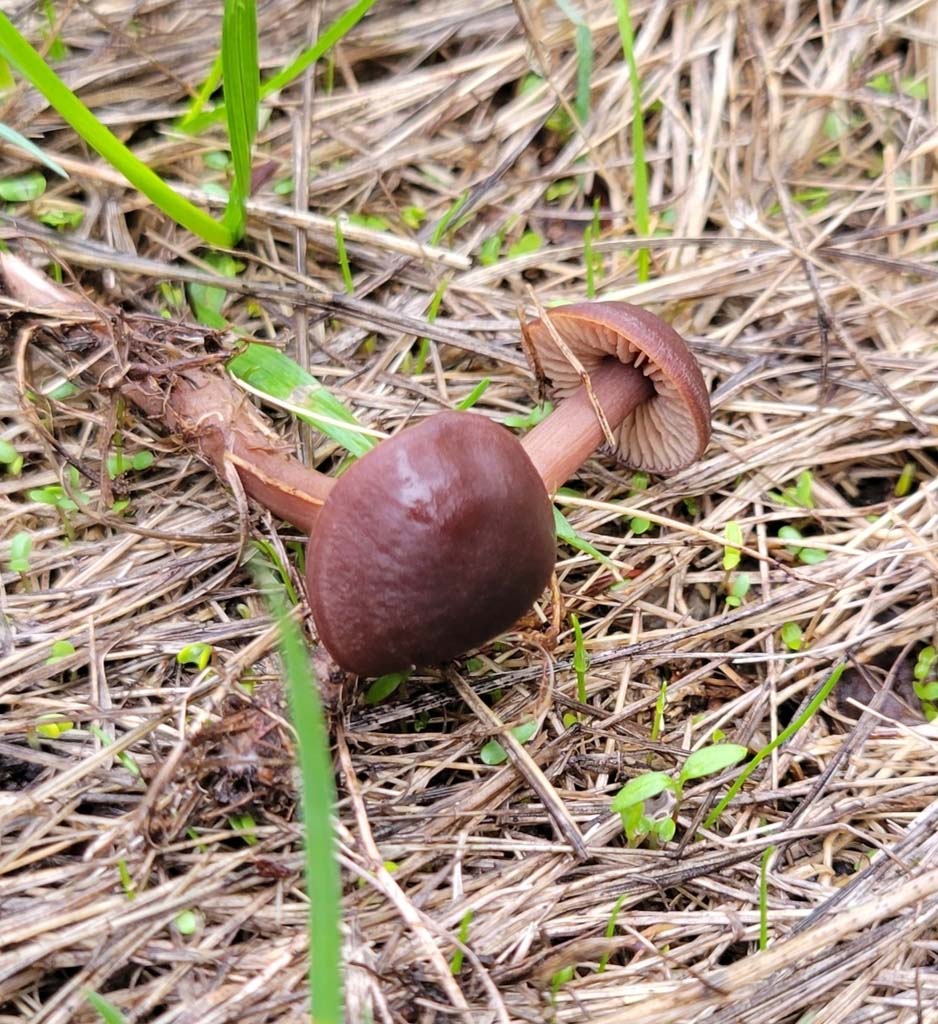
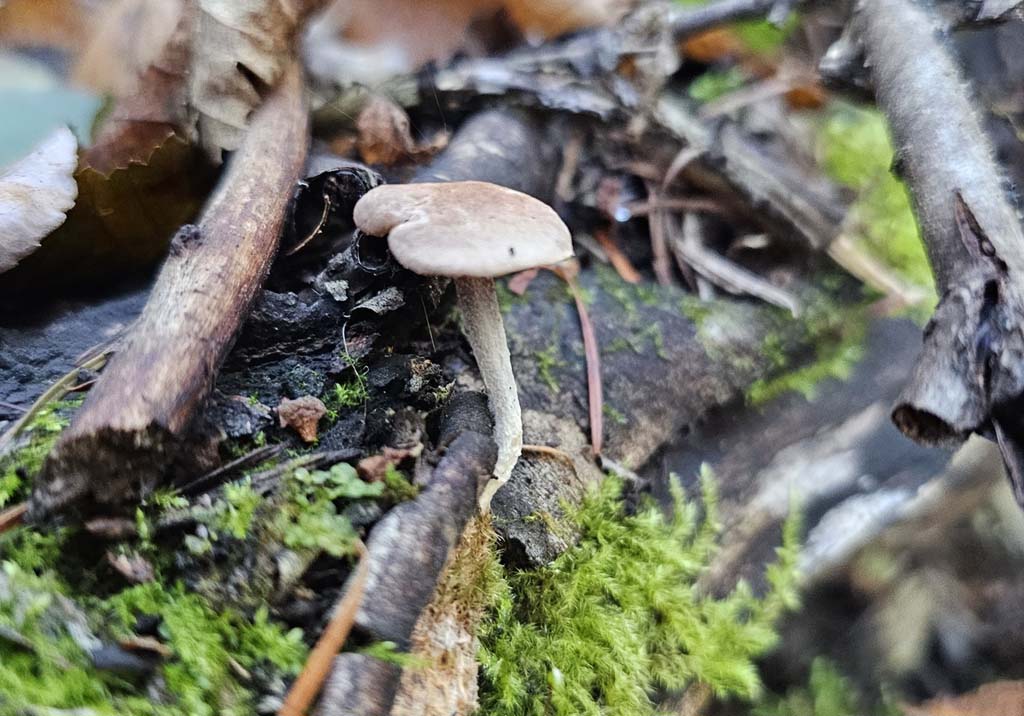
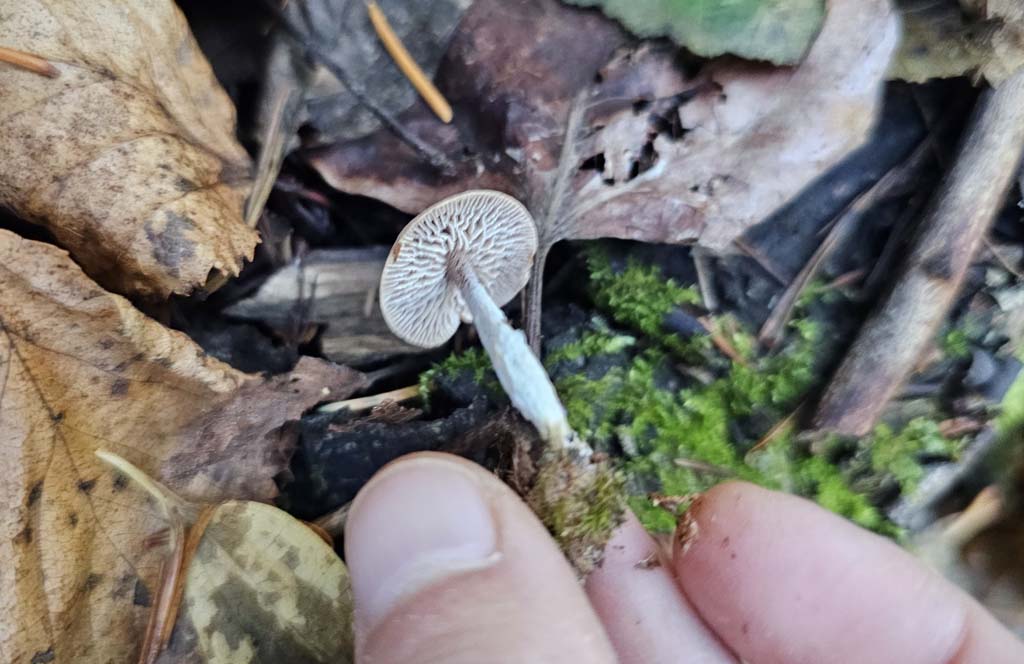
Gymnopus impudicus © Buck
McAdoo and Kendra Dedinsky, G. barbipes © Anne Polyakov
(2 images)

Gymnopus 'polyphyllus PNW03' © Colin Meyer
2. "Horsehair" Gymnopus - marasmioid (caps ~1cm across), especially wiry black "horsehair" stem
Gymnopus androsaceus
EU - smaller than the other Gymnopi, with a mostly black
(except possibly at the top) "horsehair" stem that is
very thin, wiry and black. The odor is mild. A brownish cap fades in age, but is usually
not as pale as in the similar Pseudomarasmius, below, whose stem may not
be as wiry. Collybiopsis californica, also small, lacks a truly wiry stem.
Paragymnopus species sometimes have a rotten cabbage odor, but if they
don't, they will be very difficult to differentiate as their stems can be
somewhat wiry too. Formerly in Marasmius.
One Idaho sequence
and a recent WA sequence are at least 6 bp different (1%) than numerous EU sequences,
but no micro nor ecological differences can be found. East coast sequences are
also about 1% different than both of those, so I suspect G. androsaceus
has a little more genetic variation in ITS than usual, caused by geographical
isolation.
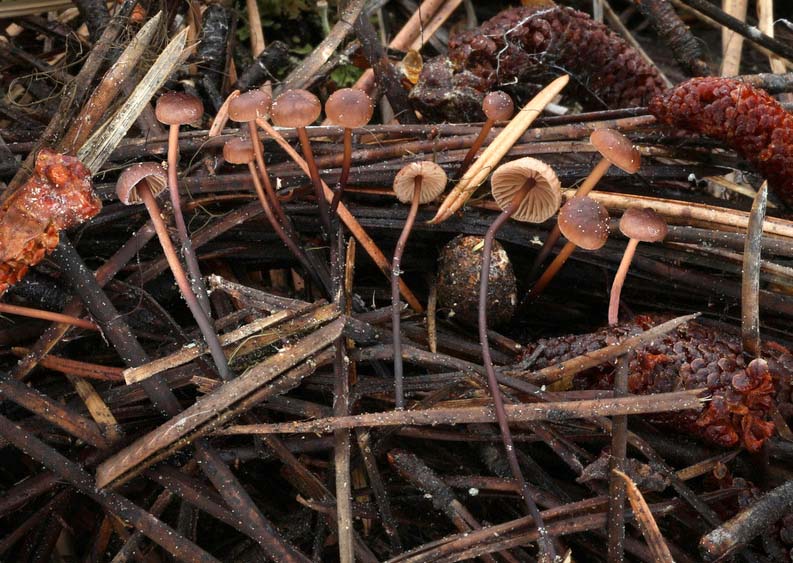
Gymnopus androsaceus © Richard Morrison
3. Collybiopsis - collybioid (caps can be >2.5cm across) (easily confused with section 1a - collybioid Gymnopus without KOH reaction
and without garlic odor)
Collybiopsis peronata UK -
usually yellow tones, a hairy stem base and distant gills.
Introduced to the PNW around the 90s but it really loves it here as it quickly
became one of our most abundant, ubiquitous mushrooms. DNA worldwide matches DNA
from Scotland, the type area.
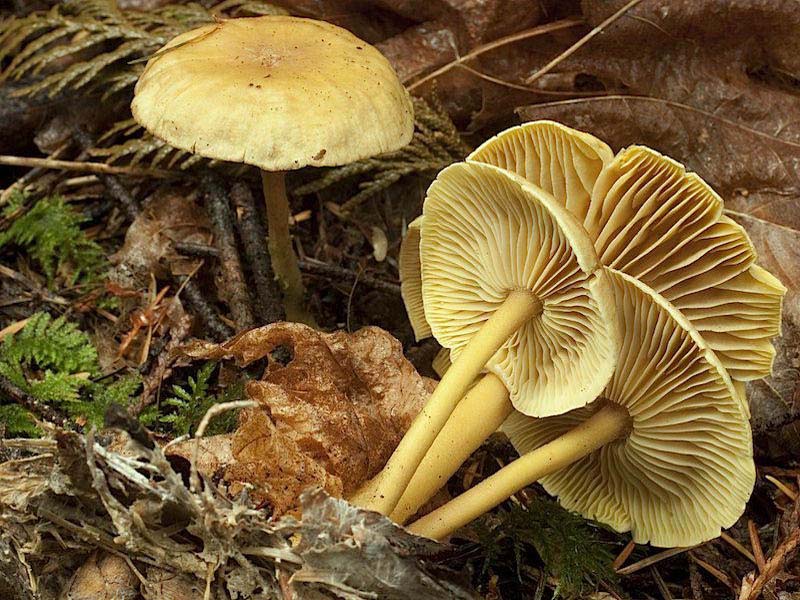

Collybiopsis peronata © Fred Rhoades and Steve Trudell
Collybiopsis confluens EU
-Collybiopsis confluens subsp.
campanulatus NY - tan to orange-brown colours (brighter when
fresh), crowded gills, a sometimes densely pubescent stem, and
some collections have a collar around the stem where it attaches to the
cap that can look like a ball-in-socket joint. The North
American subsp. campanulatus is more common here, but you can
occasionally find the original EU species as well. There doesn't seem to be a good way to
tell them apart without sequencing, they even appear to interbreed, but with the
populations 3.25% apart in ITS, they are distinct genetically. Some collections
of both varieties have odd, darker colourations.
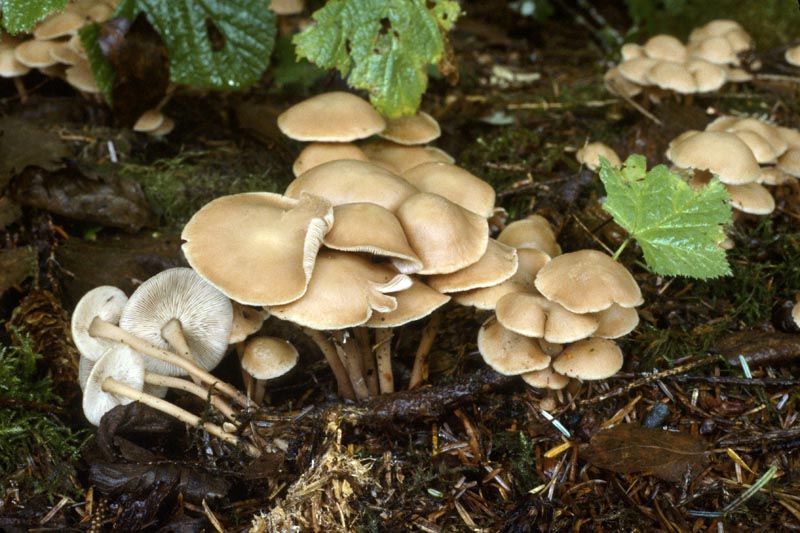
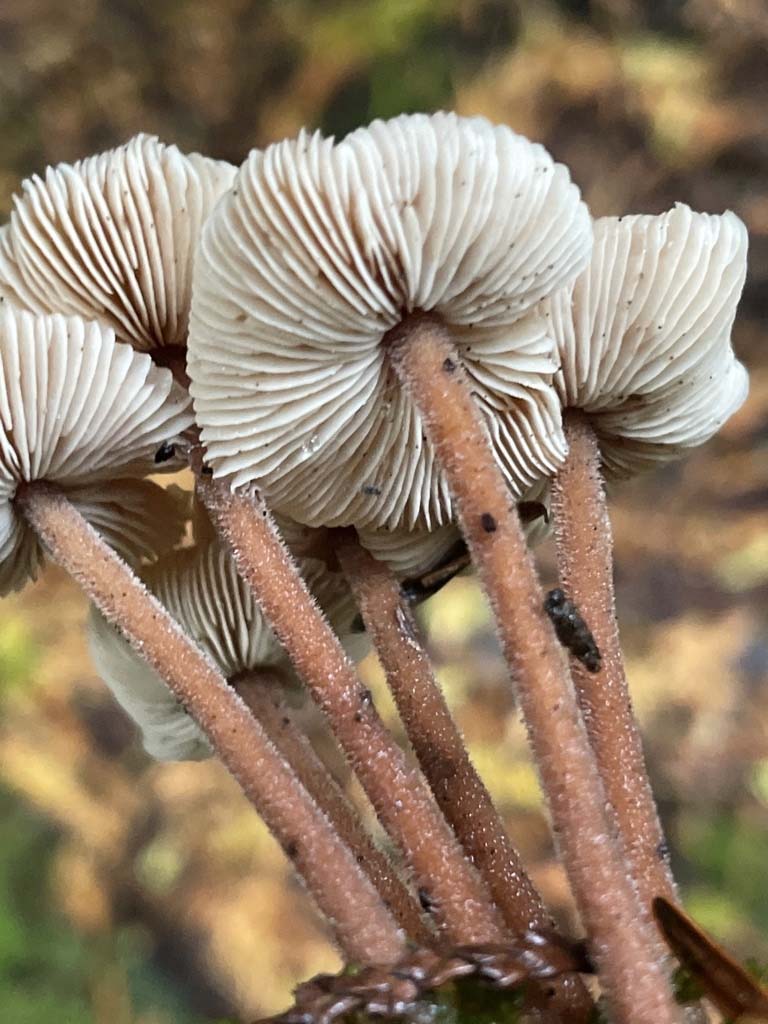
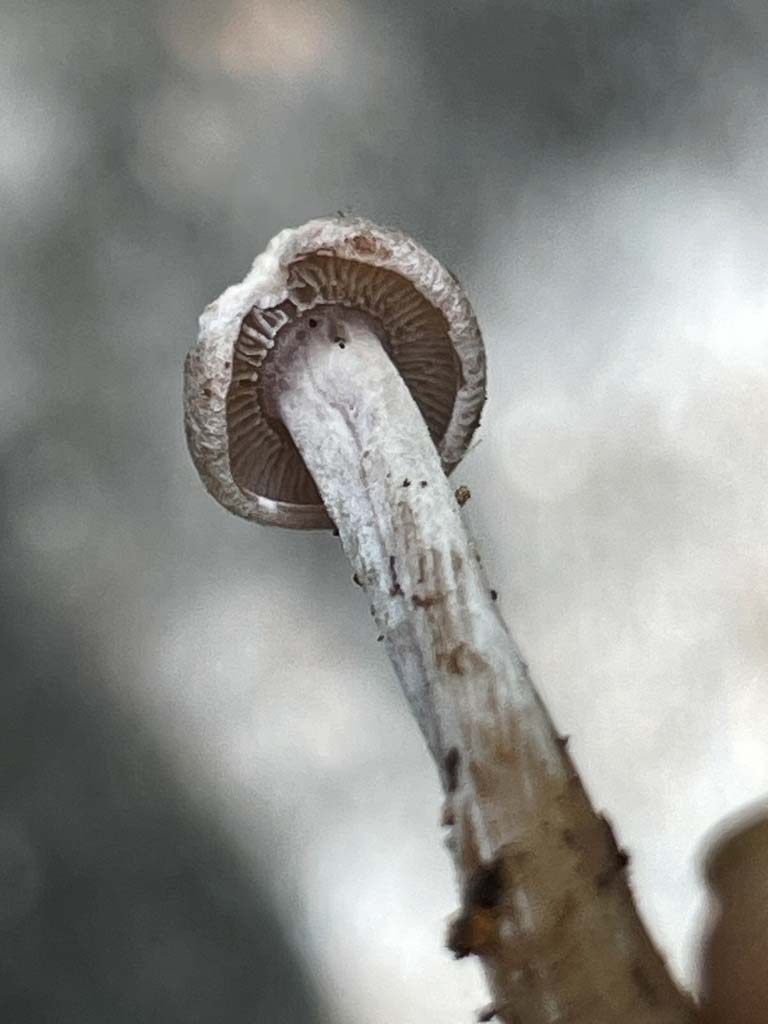
Collybiopsis confluens (usual habit, unknown subspecies) © Steve Trudell,
C. confluens subsp. confluens and subsp. campanulata (unusual habits) © Yi-Min
Wang (2 images)
Collybiopsis PNW02
- a darkly coloured decorated stem that is black at the base. (C.
villosipes has a paler stem). Two OR and two WA
collection are probably an unnamed species about 5% different than it's closest
known relative, Collybiopsis subnuda which is probably from eastern NA,
which our species has been mistaken for, but C. subnuda does not have a
decorated stem. One collection didn't look like the
others (the cap was very pleated and the entire stem black) but now we have
enough collections to know it's typical look.
An old herbarium collection (UBC F27845) labeled C. subnuda turned out to
be C. villosipes.
Collybiopsis PNW03 -
this appears to have a two or three toned stem like Gymnopus
erythropus but almost black as the bottom colour like Gymnopus cf
brassicolens above, but this species doesn't have the garlic odor. Only
found once so far in southern OR.
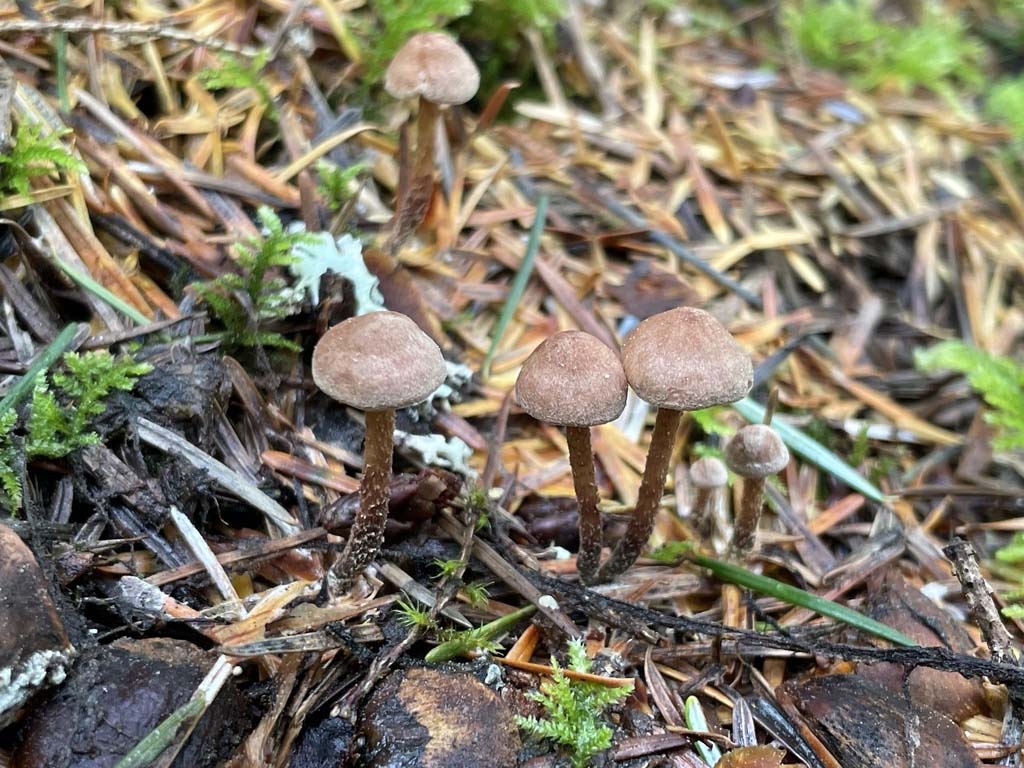

Collybiopsis PNW02 © Yi-Min Wang, Collybiopsis PNW03 © Jonathan Frank
Collybiopsis luxurians AL
- our largest species, brown cap and pale brown stem (here
shown with darker stems than normal), growing
sometimes clustered on rotten wood and in urban places like wood
chips, gardens and grass. Our sequences match NC sequences.

Collybiopsis luxurians © Eric Chandler
Collybiopsis cf. subpruinosa Jamaica
- a yellowish-brown capped species whose cap can become quite pleated.
The stem is pubescent. There
are one set of sequences from WA, CA and Chile that all match, but on the other
hand, another sequence from Puerto Rico is 10% different, and that's a lot
closer to Jamaica, the type area, so I'm not sure which is the real one.
Collybiopsis villosipes Australia
- very similar. The stems are somewhat pale, unlike PNW02. The caps may be a darker vinaceous colour, however, this
species may be striate only halfway to the disc, the cap may be more
depressed rather than umbonate, the gill edges may be lighter than
the faces, and the stems may be thicker and more pubescent compared to C.
subpruinosa. It does not have yellow tones like
Collybiopsis peronata. It could be confused with one of the undescribed species on this page. They say it
probably evolved here on the west coast and then travelled the world where it was
first described in Australia. Not all sequences appear to be the same, but some
sequences have 5 ambiguous locations accounting for most of the differences. Two
sequences purporting to be Collybiopsis biformis sequenced to be
Collybiopsis villosipes instead.

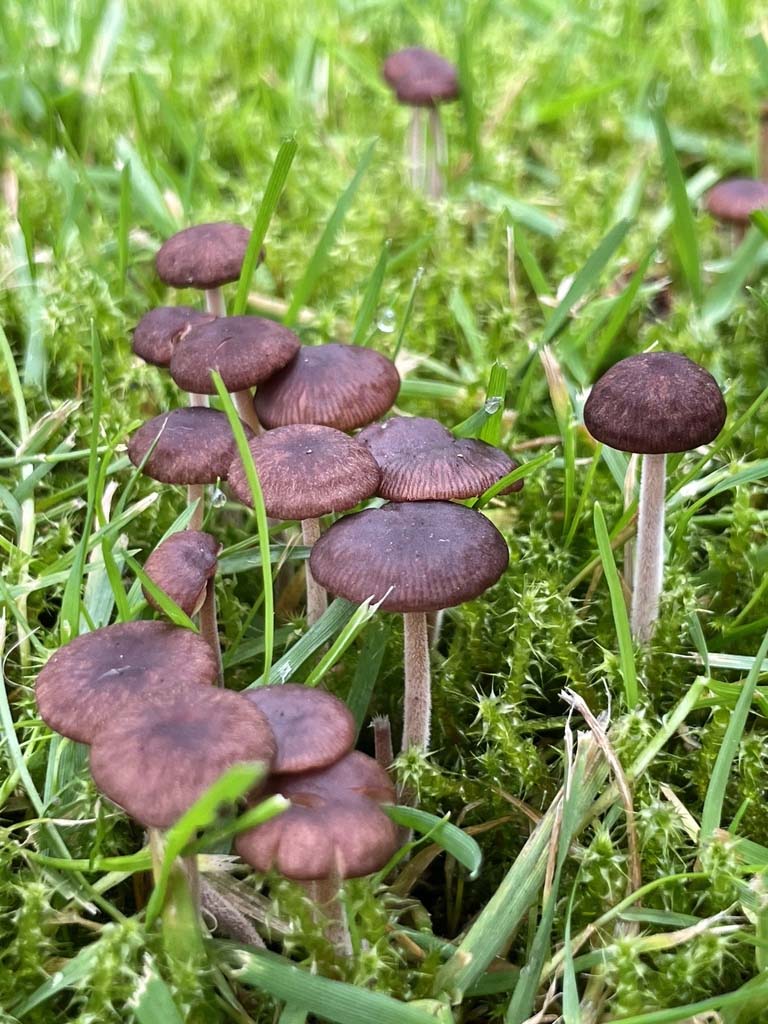

Collybiopsis cf subpruinosa © Buck McAdoo, Collybiopsis villosipes ©
Yi-Min Wang and Ann Goddard
Collybiopsis eneficola NFLD
- pale tan (almost white) in all stages of freshness with subdistant
gills and a hairy stem. Joanne Lennox found this in Idaho back in the
70s and called it Collybia tomentipes, but it finally got described for
real in 2014 in Newfoundland. Her sequence is only of ITS1 but it matches the
NFLD type sequence exactly. It has not been found since so we don't have a local
photograph. We need recent local collections. It may be a typically small
species, caps <2.5 cm across.
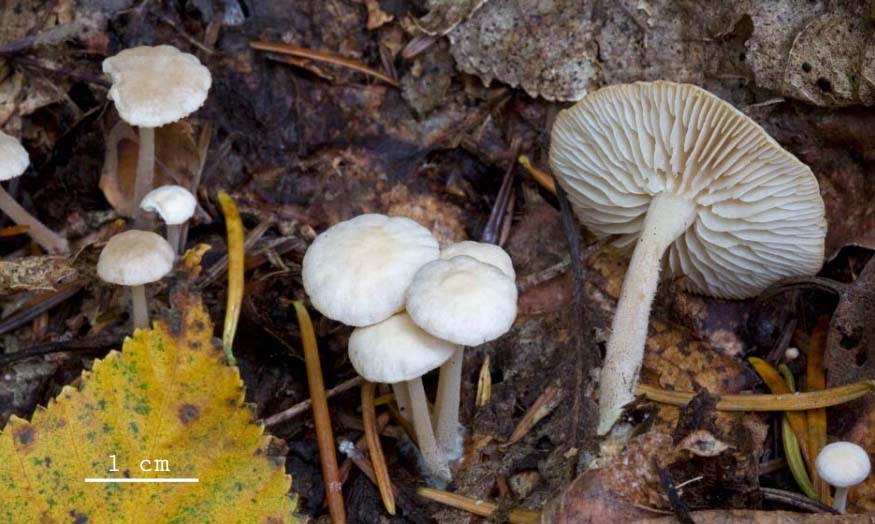
Collybiopsis eneficola Newfoundland © Andrus Voitk
'Collybia' bakerensis WA
- a small, pale collybioid growing on large conifer logs, it is
fairly non-descript with a little different stature than
Mycena (Mycenaceae)
and Clitocybula (Porotheleaceae) (found in other families of the
Marasmiineae
sub-order) that are also white with white spores and non-decurrent gills that
grow on larger pieces of wood. Being a rather small Collybiopsis and growing
directly on logs, it is not easily identified. This species still needs to be moved to the genus
Collybiopsis. We don't have a type sequence, but we have a few local
collections that all agree.
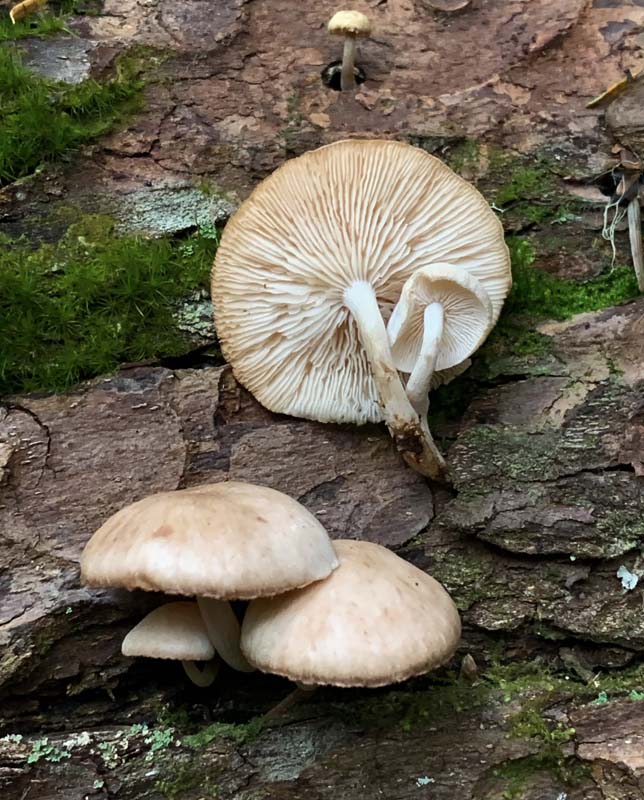
unsequenced 'Collybia' bakerensis © Andrew Parker
4. Collybiopsis - marasmioid (smaller with distant gills) (most easily
confused with
Pseudomarasmius below and the the usually darker capped Paragymnopus
that lack the strong odor sometimes found in that genus, but those usually have even thinner stems <1mm thick,
whereas these stems are usually >1mm thick).
'Collybiopsis' 'omphaloides PNW04' - a whitish cap and
multi-toned stem ranging from black at the bottom to reddish brown or paler at
the top. Probably odorless. It somewhat resembles
Collybiopsis californica, for one. It was found once in OR and once in WA
and this species is
4% different than a NZ sequence that might be Marasmiellus omphaloides.
However, these sequences are more than 25% different in ITS from any other known
sequences, so I can't tell what family it belongs to, never mind genus. We will have to sequence other genes to find out.
Since it resembles a Collybiopsis, I am treating it here, but some ITS
trees show it in the Hygrophoraceae, but without any real support.


'Collybiopsis' 'omphaloides PNW04' © Connor Dooley and
Matthew Koons
Collybiopsis californica CA 1987
-
smaller and more delicate than other Collybiopsis, with a pale cap,
distant gills and more brightly coloured red-brown stem that is
somewhat two toned. Described from oak litter in California. Note that
Marasmiellus californicus
refers to something else, Paragymnopus sequoiae.
'Marasmiellus' pluvius BC 1982
- almost the same, described from conifer litter in British Columbia. This still
needs to move to Collybiopsis.
However, the sequences we have so far on conifer litter from WA are C.
californica, not 'M.' pluvius. The only purported 'M.' pluvius
sequence we have is from Tennessee, so I have a theory that the two species are
the same and can live on either kind of litter and that the TN species is undescribed.
Collybiopsis quercophila CA - this species is to be looked for, at least
in Oregon. We need a good way to tell it apart from C. californica.
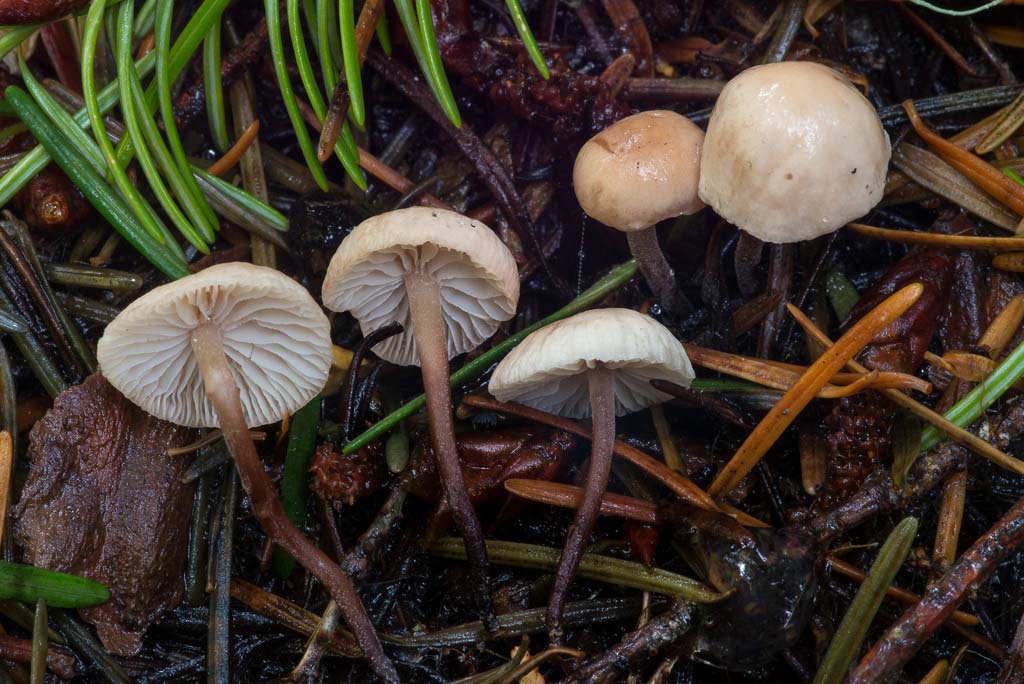
Collybiopsis californica © Connor Dooley
Collybiopsis 'hasanskyensis PNW01' - typical reddish brown cap fading to very pale, but
the stem usually retaining some colour, occasionally almost two toned, which makes it much
like Gymnopus erythropus above, but this species appears to have very
distant gills. Two WA collections surprised us by being 7 bp and 3 indels
different than official sequences of this Russian species. That may be enough
to imply that ours needs its own name.

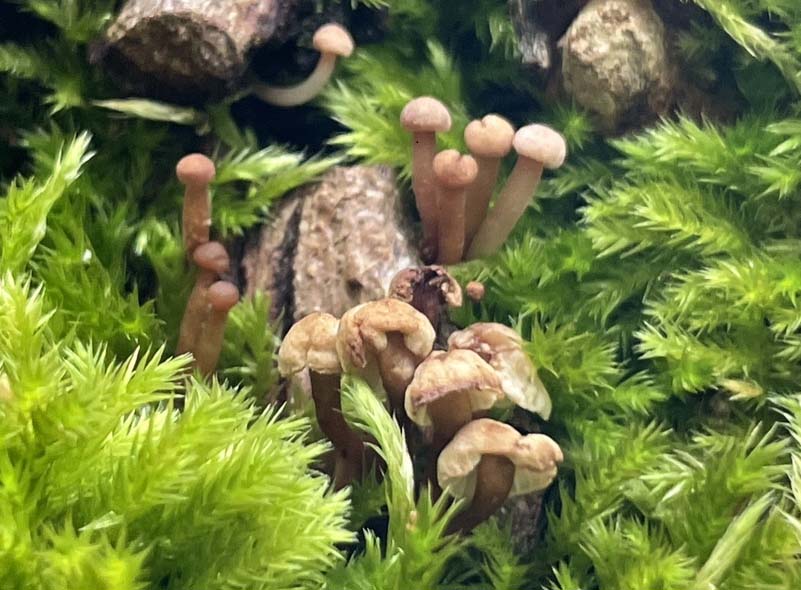

Collybiopsis 'hasanskyensis PNW01' © Yi-Min Wang (2 images) and
Connor Dooley
Collybiopsis cf. vaillantii EU
- perhaps a paler cap, more decurrent gills, and stem that only
darkens at the bottom (compared to the previous two, which it is not that
closely related to). Reported from the PNW, but not proven, perhaps reports of
this represent one of the above species. We need local collections, but we
also need EU sequences to compare to, as we only have one purported ENA sequence
to compare to right now, which might be misidentified.
'Marasmiellus' papillatus NY
- this small nondescript species was reported from the PNW but not proven, we
don't have any DNA yet so we don't even know if it really belongs in
Collybiopsis. We need collections.
'Marasmiellus' filopes NY
- this mildy garlicky small species was reported from the PNW but not
proven, we don't have any DNA yet so we don't even know if it really belongs in
Collybiopsis. We need collections.
5. Other Gymnopi to look for
'Gymnopus' quinaultii WA - is small. Nobody is sure what this local
species is, and there is no DNA yet, so we desperately need collections to find
out for sure what genus it is really in and if it really is a unique species.
Most of the other small Gymnopus described in the same paper turned out
to belong to Paragymnopus (below).
'Gymnopus' putillus EU - wine-red
cap and gills contrast with a very pale entirely pubescent stem.
Reports of this species being here have not been verified, nor do we even know
what it really is, although UNITE has two sequences claiming to be this. One Idaho collection from 100 years ago with this name turned
out to sequence inside Rhodocollybia (see Rhodocollybia IN01 below).
Two recent collections from BC sequenced to be Gymnopus PNW10.
Gymnopus cf. fusipes
EU
- has a spindle shaped rooting stem, distant gills and spots
red-brown all over. Nobody really believes the vague report that it might be
in the PNW, but keep an eye out for it anyway. We have a bunch of EU type area
sequences.
Peckorumyces umbonatus NY (=Gymnopus contrarius NY) - this garlic
mushroom is probably best recognized by extremely thick walled cystidia. It
recently got a genus of its own, so it
certainly is a contrary species. It has been recorded from AK, CO, and AZ, but not yet
from the lower PNW.
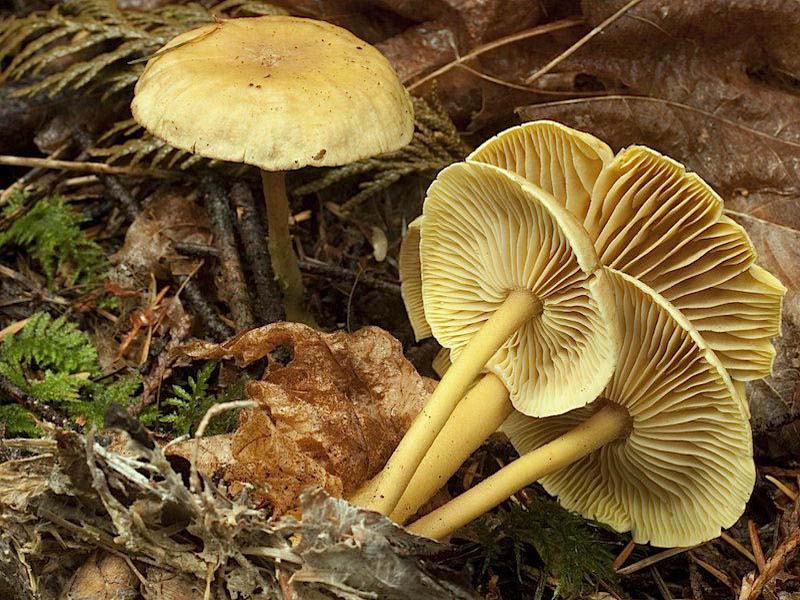
 Gymnopus and Collybiopsis (Marasmiellus) - click to expand
Gymnopus and Collybiopsis (Marasmiellus) - click to expand
 Mycetinis - click to expand
Mycetinis - click to expand
 Paragymnopus - click to expand
Paragymnopus - click to expand
 Rhodocollybia, Connopus, Pseudomarasmius, etc. - click to expand
Rhodocollybia, Connopus, Pseudomarasmius, etc. - click to expand